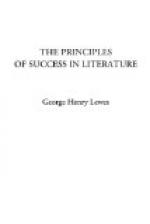It should be added that Burke came very near a true explanation in the following passage:—“It is difficult to conceive how words can move the passions which belong to real objects without representing these objects clearly. This is difficult to us because we do not sufficiently distinguish between a clear expression and a strong expression. The former regards the understanding; the latter belongs to the passions. The one describes a thing as it is, the other describes it as it is felt. Now as there is a moving tone of voice, an impassioned countenance, an agitated gesture, which affect independently of the things about which they are exerted, so there are words and certain dispositions of words which being peculiarly devoted to passionate subjects, and always used by those who are under the influence of passion, touch and move us more than those which far more clearly and distinctly express the subject-matter.” Burke here fails to see that the tones, looks, and gestures are the intelligible symbols of passion—the “images’ in the true sense just as words are the intelligible symbols of ideas. The subject-matter is as clearly expressed by the one as by the other; for if the description of a Lion be conveyed in the symbols of admiration or of terror, the subject-matter is then a Lion passionately and not zoologically considered. And this Burke himself was led to admit, for he adds, “We yield to sympathy what we refuse to description. The truth is, all verbal description, merely as naked description, though never so exact, conveys so poor and insufficient an idea of the thing described, that it could scarcely have the smallest eflfect if the speaker did not call in to his aid those modes of speech that work a strong and lively feeling in himself. Then, by the contagion of our passions, we catch a fire already kindled in another.” This is very true, and it sets clearly forth the fact that naked description, addressed to the calm understanding, has a different subject-matter from description addressed to the feelings, and the symbols by which it is made intelligible must likewise differ. But this in no way impugns the principle of Vision. Intelligible symbols (clear images) are as necessary in the one case as in the other.




